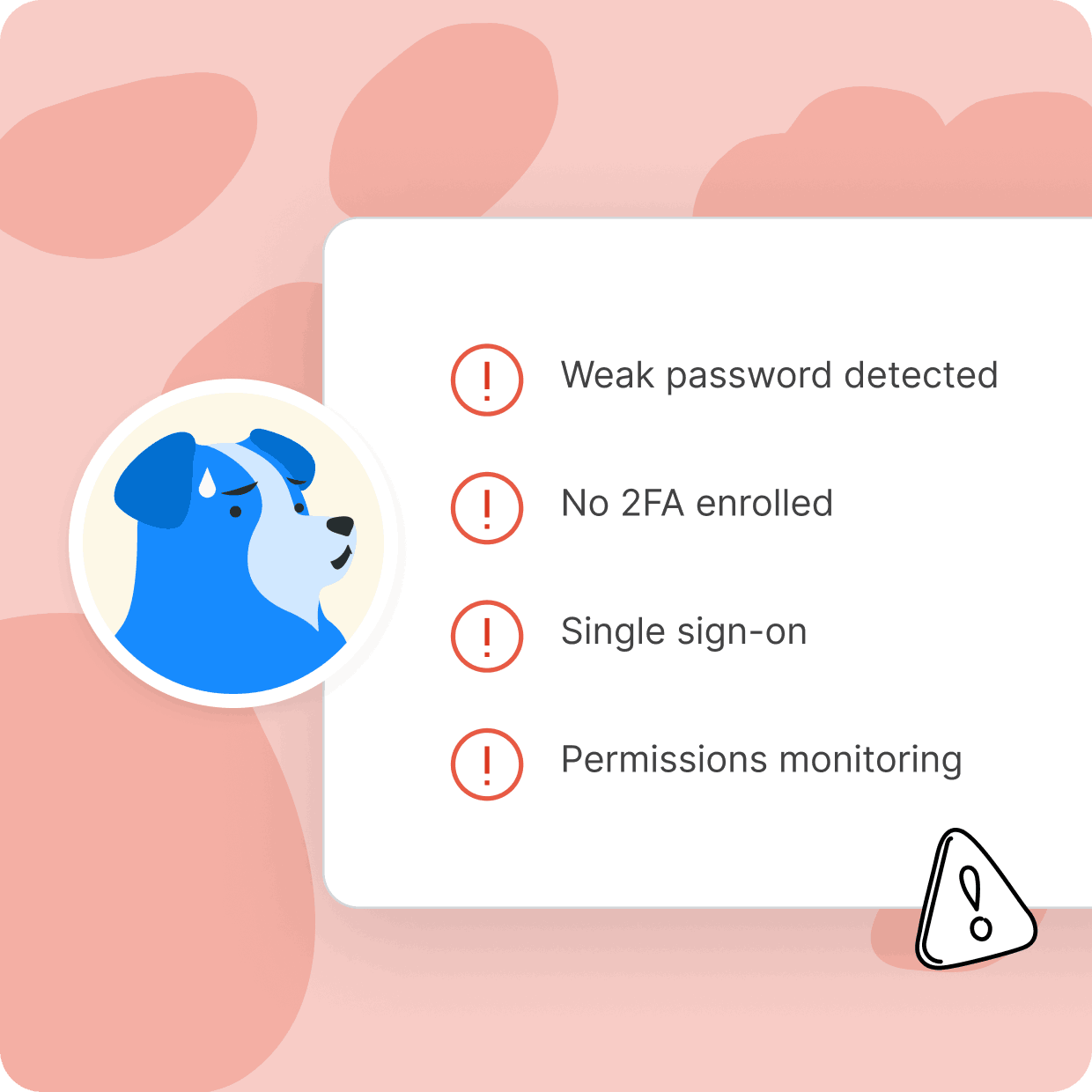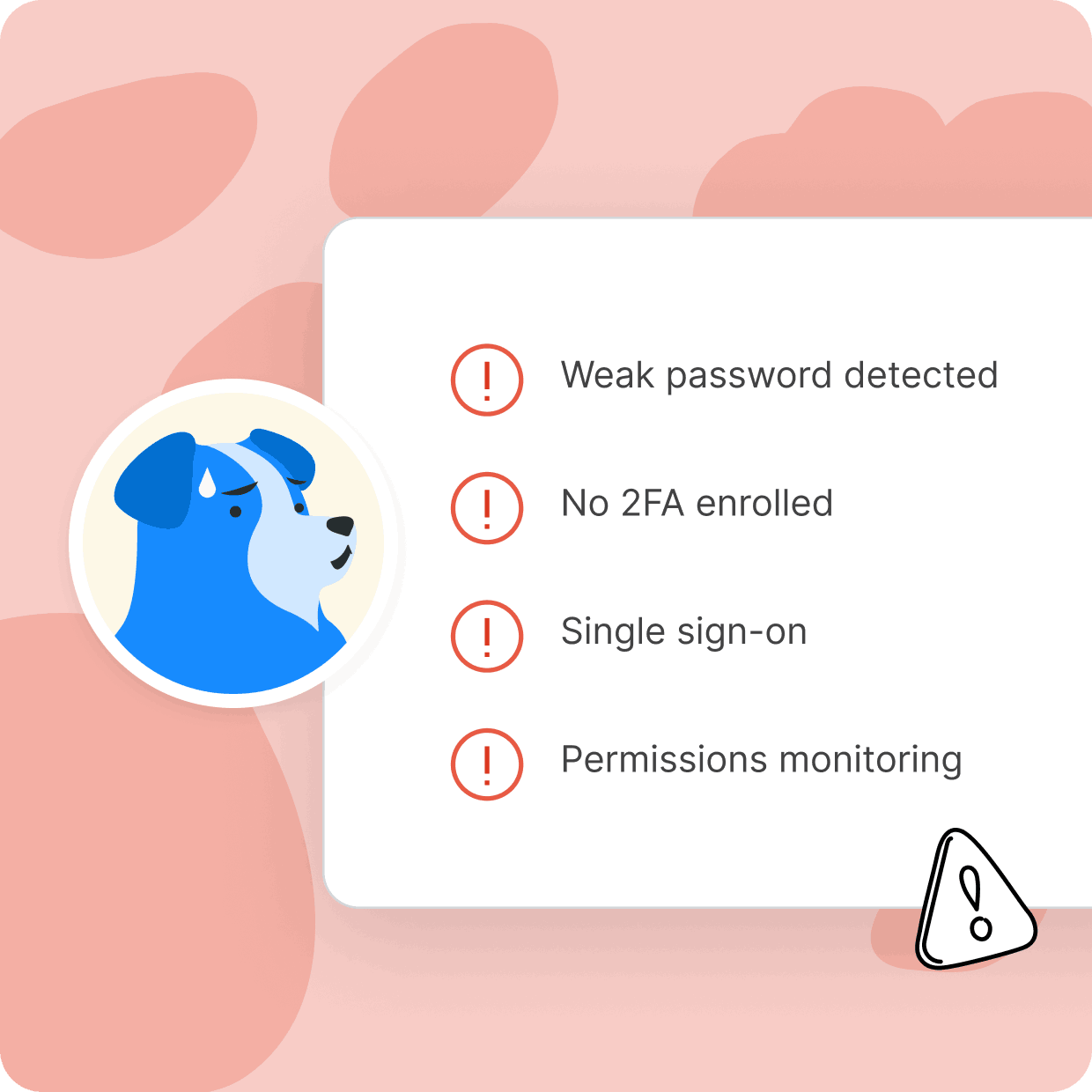CASB Cyber Security
CASB, Cloud Access Security Broker, is a crucial component of cyber security in the context of SaaS. CASBs act as intermediaries between users and cloud service providers, monitoring and controlling the data flowing between them. CASB provides security measures such as data encryption, access controls, threat detection, and activity monitoring to ensure the safe usage of SaaS applications. This helps organizations maintain visibility and control over their data in the cloud, protecting against data breaches, insider threats, and unauthorized access.
Cerby allows you to manage all your SaaS administrator accounts, rotate credentials, and monitor and audit privileged account activities. In this guide, you'll learn about different PAM tools, the challenges, and the players.

Secure privileged accounts
Not all accounts are created equal. Some come with administrative permissions that put sensitive data at risk when in the wrong hands. With Cerby, you can help protect your business from bad actors, mistakes, and data breaches.
With Cerby you can

Secure your SaaS admin accounts
Cerby is a secure and easy way to manage SaaS privileged accounts, rotate credentials, and monitor activity for all your accounts in one place. Get the peace of mind that comes with knowing that your data is safe from unauthorized access or data breaches. Cerby allows you to share access to administrative accounts and know they are secure and protected by 2FA.

Protect your business from data breaches
Make sure you protect your business from bad actors, mistakes, and data breaches with secure and rotating privileged account credentials based on SCIM events from your identity provider. Cerby gives you the control and visibility to keep your SaaS crown jewel accounts safe.
Eliminate the costs of custom integrations
Cerby's SaaS privilege account management eliminates the need for expensive custom integrations by enabling access to any application without additional development fees. Manage your SaaS crown jewels with greater visibility and control, while reducing costs and streamlining security operations. With Cerby, get the privileged access you need without the custom integration price tag.
Secure your SaaS accounts and achieve better compliance with Cerby
What is CASB cyber security?
In a world increasingly reliant on cloud technology, the security of cloud-based data and applications is more crucial than ever. Organizations can adopt CASB (Cloud Access Security Broker) solutions to help secure the management of cloud-based assets. CASB cyber security provides organizations with some of the necessary tools to protect their data against internal and external threats.
CASB solutions enable users to gain visibility into their cloud environments to track user activity and detect potential security threats. This, in turn, allows the enforcement of security policies to secure cloud applications access and data flow both within and outside an organization's infrastructure. Furthermore, CASB solutions can be combined with other security solutions such as ZTNA (Zero Trust Network Access) and SASE (Secure Access Service Edge).
CASB cyber security is essential for companies that rely on the cloud, as it offers them the added benefit of centralized control over sensitive data and streamlined security operations. Additionally, with the rise of remote work and Bring Your Own Device (BYOD) policies, CASB security has become even more critical as employees use personal devices and unsecured networks to access company data via the cloud. CASB provides organizations the visibility and control to securely manage remote workforces without sacrificing data privacy.
The importance of CASB cyber security cannot be overstated. By implementing CASB solutions, companies can protect their data and cloud applications against cyber threats while improving their remote work practices. CASB solutions offer a comprehensive approach to securing cloud-based assets, protecting against unauthorized access and data loss, and setting policies that promote better security and compliance. However, they don’t address one big challenge: many applications don’t support the security standards necessary to work with identity providers, e.g., SSO—namely, the security assertion markup language (SAML). These applications, often called nonfederated applications, are a severe security risk, and research from the Ponemon Institute found that they make up a statistically significant percentage of breaches.
How does CASB work?
Cloud access security brokers offer effective cybersecurity solutions that enable organizations to monitor and control their cloud services securely. But how does CASB work? At its core, a CASB solution acts as a gateway and provides a range of security features, including real-time monitoring, data protection, encryption, user behavior analysis, and more.
Countless real-world use cases demonstrate the effectiveness of CASB solutions. For example, a multinational corporation that uses Google Workspace for its business activities could deploy a CASB solution to protect its data and intellectual property. The CASB solution would provide a dashboard to enable security teams to track user activities across the cloud environment. This way, they could watch for potential breaches and enforce critical security policies to protect confidential data.
In another example, a large financial institution struggling to control its employees' use of unlicensed cloud services could deploy a CASB solution to track employees’ activities and detect unauthorized access. The solution could also enable them to block unauthorized applications, providing an additional layer of security.
Many organizations can leverage CASB solutions to achieve a more robust cybersecurity posture. CASB implementation helps organizations avoid cybersecurity threats and provides a comprehensive view of user activities across their cloud services. It also helps to enforce critical security policies in real-time. CASB solutions offer potent capabilities to protect organizations' data and assets by acting as a cybersecurity gateway.
CASB solution
The growing trend toward cloud adoption has driven the need for cloud security solutions like CASB in recent years. CASB solutions offer organizations visibility into and control over sensitive data in cloud applications, even when accessed from unmanaged and personal devices. CASB vendors can also provide SASE security for organizations that require more than just the traditional perimeter-based security approach.
One of the most prominent CASB vendors in the market is Microsoft CASB, also known as Microsoft Defender. Microsoft Defender offers a range of features that integrate with the Microsoft ecosystem, which makes it a popular choice for Microsoft security customers. Some of the benefits offered by Microsoft CASB include the following:
- Real-time monitoring
- Data loss prevention
- Cloud app discovery
- The ability to enforce compliance policies
Netskope CASB is another leading solution that provides robust cloud security. Their CASB offering integrates with their SASE platform and offers features such as zero-trust network access, cloud storage protection, and continuous threat protection. Additionally, Netskope CASB simplifies the cybersecurity stack by combining capabilities and accelerating incident response time.
Microsoft and Netskope CASBs are not the only solutions available today. However, these two contenders stand out due to their robust suite of features and ability to integrate with other security tools. Although these solutions have differentiating features, they share a common goal: to secure cloud environments with enhanced visibility and real-time threat detection capabilities.
CASB solutions have become critical for organizations transitioning their IT operations into cloud-based environments. Solutions like Microsoft CASB and Netskope CASB provide the necessary security measures for organizations to detect and mitigate risks while protecting their data, applications, and systems against cyberattacks. By selecting a CASB solution that fits their specific security needs, organizations can continue to innovate and leverage cloud technology confidently.
CASB tools
CASB tools provide critical security features for organizations to secure cloud operations and protect sensitive data and systems against cyber threats. Each available CASB tool offers unique features and use cases.
Other CASB tools available include Symantec and Zscaler.
- Symantec CASB provides integrated cloud DLP (Data Loss Prevention) functionality. CASB DLP use cases include increasing data protection while still providing end-user productivity.
- Zscaler CASB provides deep visibility into cloud usage and threat protection and makes it easier to manage policy and compliance across all cloud services.
While some CASB products may differ in their feature sets, their end goals remain consistent – securing cloud environments with enhanced visibility and real-time threat detection capabilities.
There are numerous use cases for CASB tools. For example, organizations dealing with sensitive data could deploy a CASB tool to mitigate the risk of data leakage and unauthorized access. Organizations can also use CASB tools for real-time threat detection, security policy management, compliance monitoring, shadow IT detection, and more.
CASB tools have become an essential ingredient in the cybersecurity landscape. When evaluating CASB software, organizations should consider factors like:
- Deployment options
- Integration with existing systems
- The extent of control over cloud activities
- Additional security features like DLP
By selecting the right CASB products for their specific security needs, organizations can confidently adopt cloud services and ensure that their data remains secure.
CASB vs. ZTNA vs. SASE
CASB solutions differ from other security solutions such as ZTNA and SASE. Although both CASB and SASE solutions provide end-to-end security, CASB focuses on securing cloud resources, while SASE emphasizes network security. Zero trust network access is another security protocol that CASB often incorporates. ZTNA makes sure that every access request is authenticated, authorized, and encrypted before granting it access to a network.
CASB vs. SASE are two popular technologies in the field of cloud security. While both focus on securing cloud-based resources, there are some critical differences between them. CASB security primarily operates as a mediator between cloud service providers and users to ensure secure data access and sharing. CASB solutions monitor and analyze activity across cloud environments and provide greater control over cloud services.
On the other hand, SASE architecture is based on the convergence of networking and security. SASE security provides a unified cloud-based platform that delivers a range of security and networking services. It offers access and security capabilities as a service, providing secure access to cloud services from any location or device.
SASE vs. SSE (Secure Service Edge) is another comparison businesses often make. While both SSE and SASE provide a secure edge, SSEs are typically provided by cloud-based infrastructure providers, while SASEs are delivered as a service offering by security vendors. Furthermore, SASE ZTNA combines the security principles of both SASE and ZTNA, delivering a highly secure network environment by ensuring that all users and devices are authenticated before accessing cloud resources.
While both CASB and SASE focus on cloud security, they use different approaches. CASB primarily focuses on securing cloud access, while SASE is a more comprehensive approach incorporating networking and security. Businesses should evaluate their specific requirements and choose the technology that aligns with their goals.


